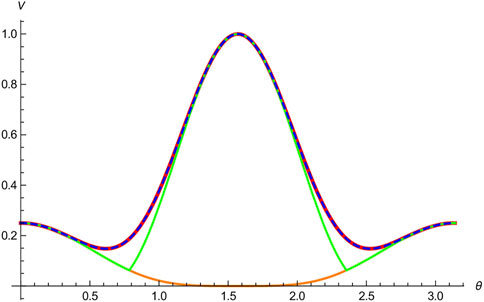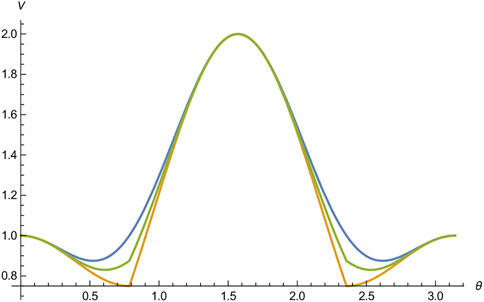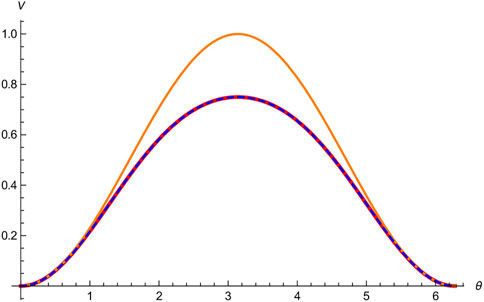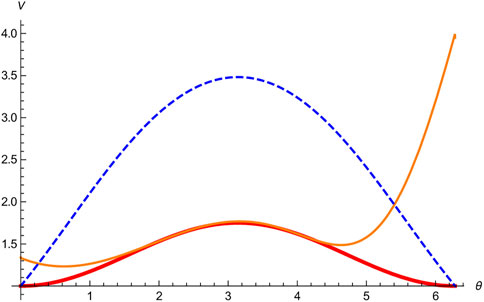
95% of researchers rate our articles as excellent or good
Learn more about the work of our research integrity team to safeguard the quality of each article we publish.
Find out more
ORIGINAL RESEARCH article
Front. Phys. , 01 April 2022
Sec. Quantum Engineering and Technology
Volume 10 - 2022 | https://doi.org/10.3389/fphy.2022.846330
This article is part of the Research Topic Uncertainty Relations and Their Applications View all 10 articles
Learning physical properties of a quantum system is essential for the developments of quantum technologies. However, Heisenberg’s uncertainty principle constrains the potential knowledge one can simultaneously have about a system in quantum theory. Aside from its fundamental significance, the mathematical characterization of this restriction, known as ‘uncertainty relation’, plays important roles in a wide range of applications, stimulating the formation of tighter uncertainty relations. In this work, we investigate the fundamental limitations of variance-based uncertainty relations, and introduce several ‘near optimal’ bounds for incompatible observables. Our results consist of two morphologically distinct phases: lower bounds that illustrate the uncertainties about measurement outcomes, and the upper bound that indicates the potential knowledge we can gain. Combining them together leads to an uncertainty interval, which captures the essence of uncertainties in quantum theory. Finally, we have detailed how to formulate lower bounds for product-form variance-based uncertainty relations by employing entropic uncertainty relations, and hence built a link between different forms of uncertainty relations.
Uncertainty principle, originally introduced by Heisenberg [1], clearly sets quantum theory apart from our classical world. Formally, it states that it is impossible to predict the outcomes of incompatible measurements simultaneously, such as the position and momentum of a particle. The corresponding mathematical formulation for position and momentum are given by Kennard in Ref. [2] (see also Ref. [3]). Later, a general form of uncertainty relation has been established by Robertson [4], and has been further improved by Schrödinger in Ref. [5], which is expressed in terms of commutator and anticommutator of obserables:
where the quantity
Riding the waves of information theory, entropies have been used to quantify the uncertainties associated with quantum measurements [14]. For instance, the entropies of probability distributions of canonically conjugate variables obey Białynicki-Birula-Mycielski uncertainty relation [15]. It is noteworthy that Heisenberg’s uncertainty relation follows from Ref. [15] as a special case. The entropic uncertainty relation for any pair of bounded observables is established by Deutsch in Ref. [16]. An improved expression was subsequently conjectured by Kraus [17] and then had been proved by Maassen and Uffink [18]. With access to a memory system, the conventional entropic uncertainty relations have been further generalized to entanglement-assisted formalism [19]. Soon afterwards, several improvements and extensions, including the cases of multiple measurements, universal uncertainty regions and quantum processes, have been proposed in Refs. [20–25]. Recently, beyond inertial frames, the uncertainty trade-off occurred near the event horizon of a Schwarzschild black hole [26] and the relativistic protocol of an uncertainty game in the presence of localized fermionic quantum fields inside cavities [27] have also been demonstrated.
Aside from their theoretical significance [28], these uncertainty relations support a variety of applications and have been widely used in current quantum technologies, such as analyzing the security of quantum key distribution protocols [19], witnessing quantum correlations [29–32], and even inferring causality from quantum dynamics [33]. Thus, pushing the boundary of uncertainty relation will not only deepen our understanding of quantum foundations, but also has impact on practical applications.
In this work, we focus on the case of variance-based uncertainty relations, with the forms of both product and summation, and introduce the concept of uncertainty interval. The formulation of such an interval can of course be subdivided into two, namely finding the lower bound and upper bounds for joint uncertainties. To do so, we establish the partial Cauchy-Schwarz inequality, which generalizes the standard Cauchy-Schwarz inequality, and use this toolkit to construct near-optimal bounds for variance-based uncertainty relations. Numerical results highlight the advantages of our framework.
Throughout this paper, we consider quantum systems acting on finite-dimensional Hilbert space. Let us start with a pair of incompatible observables A and B, and denote their spectral decompositions as A = ∑iai|ai⟩⟨ai| and B = ∑ibi|bi⟩⟨bi| respectively. On the other hand, assume the alternative observable
and thus we have
It now follows from Cauchy-Schwarz inequality immediately that
We note that such a choice of xi and yi leads directly to the main results presented in a recent formulation of strong uncertainty relation [34]. Clearly, this is not the only choice of xi and yi. By setting xi as
A key observation in this work is that any improvement over the well-known Cauchy-Schwarz inequality will give us a better bound of variance-based uncertainty relation, with the same amount of information required in Eq. (4). To this end, we investigate the intrinsic connection between the arithmetic-geometric mean (AM-GM) inequality and the Cauchy-Schwarz inequality. We start by writing down the product of
Above inequality is a result of n (n − 1)/2 rounds of AM-GM inequalities for
we can write the left-hand-side of Eq. 4 as
which is precisely the product-form joint uncertainty. On the other hand, the previous known bound in Ref. [34], i.e. right-hand-side quantity of Eq. 4, can be reformatted as
Now we introduce a chain of inequalities that outperform Cauchy-Schwarz inequality. More precisely, we have.
Theorem 1. For any n-dimensional real vectors
Actually, for any index k it follow from the AM-GM inequality that
as required. Algebraically, the inequality
which offers a stronger bound than that of
Note that the method of constructing bounds presented here for variance-based uncertainty relations requires the same amount of information, i.e. the fidelity between quantum state and the eigenvector of observables, needed in previous works, such as the one considered in Ref. [34], but provable tighter.We now move on to further strengthening the bounds of uncertainty relations by considering the action of symmetric group
It is straightforward to check that the quantity I0 is stable under the action of
Theorem 2. For any permutations
Optimizing over the symmetric group
Theorem 3. For any permutations
Mathematically, above inequalities are tighter than the result in Thm. 1, since
In this section we turn our attention to the sum-form variance-based uncertainty relations. Before doing so, let us recall the rearrangement inequality first. Let (xi) and (yi) be two n-tuple of real positive numbers arranged in non-increasing order, namely xi ≥ xi+1 and yi ≥ yi+1, with their direct sum, random sum and reverse sum between xi and yi being defined as
Then the following lemma characterizes the relationship among these quantities; that is.
Lemma. (Rearrangement inequality) For any two non-increasing n-tuples x and y of nonnegative numbers, we have
From the parallelogram law, the summation of variances can be re-expressed as
Combining with the rearrangement inequality we obtain the following result.
Theorem 4. For any two permutations
Remark that, by setting π1 = (1), our newly constructed uncertainty relation outperforms similar results of sum-form variance-based uncertainty relation considered in Ref. [34]. We denote by
Quantum theory does not only impose restrictions on the lower bounds of uncertainties, but also sets limitations on the upper bounds of uncertainties [34], which are known as reverse uncertainty relations in the literature. In this section, we investigate the reverse uncertainty relations for both the product-form and sum-form uncertainty relations, and introduce several tighter bounds. Consequently, our lower bounds presented in previous sections together with the results obtained in this section lead to intervals for joint uncertainty, which are referred as uncertainty intervals.
For index 1 ≤ i ≤ n, we define
Using the rearrangement inequality, we thus see that
By taking minimum over all permutations
which proves that the joint uncertainty of incompatible observables A and B (for the product-form) is restricted within the interval
On the other hand, using the fact
Recalling the definitions
Denote the right-hand (RHS) of (25) by
In this section we provide numerical examples to show how the bounds obtained in this work outperform previous strong results [34]. First of all, let us consider the spin-1 particle with the state |Ψ(θ)⟩ = cos θ|1⟩ − sin θ|0⟩, where the state |0⟩ and |1⟩ are eigenstates of the angular momentum Lz. We investigate the uncertainty associated with angular momentum operators for spin-1 particle, namely A = Lx and B = Ly. To formulate bounds for uncertainty relations, we choose
In Figure 1, our bound

FIGURE 1. Lower bounds of V(A)V(B) for a family of spin-1 particles |Ψ(θ)⟩: the product-form uncertainty relation V(A)V(B), the bound

FIGURE 2. Lower bounds of V(A) + V(B) for a family of spin-1 particles |Ψ(θ)⟩: the sum-form uncertainty relation V(A) + V(B), our bound
Let us move on to considering the spin-
where the two incompatible observables are taken as A = σx and B = σz. In Figure 3, it has been shown that our upper bound

FIGURE 3. Upper bounds of V(A)V(B) for a family of spin-1/2 particles ρ(θ): the product-form uncertainty relation V(A)V(B), our bound

FIGURE 4. Upper bounds of V(A) + V(B) for a family of spin-1/2 particles ρ(θ): the sum-form uncertainty relation V(A)V(B), our bound
Apart from constructing stronger uncertainty relations, our method introduced in Sec. II also helps to fill up the gap between product-form variance-based uncertainty relations and entropic uncertainty relations. Following Ref. [35], we have
where H (⋅) stands for the Shannon entropy and c is a state-independent constant. Using Thm. 1, it is straightforward to check that
On the one hand, the term
Therefore both the incompatibility between observables and mixness of the quantum state will affect the variance-based uncertainty relations. Moreover, any entropic uncertainty relation can be employed to construct a lower bound for product-form variance-based uncertainty relation.
To summarize, we have introduced several variance-based uncertainty relations both in the sum and product forms. Our results contain both the lower bounds and the upper bounds, which leads to the concept of uncertainty intervals. Numerical experiments illustrate the advantages of our bounds, and in some cases our bounds are near optimal. Quite remarkable, our method in deriving stronger variance-based uncertainty relations also fills the gap between the product-form variance-based uncertainty relations and the entropic uncertainty relations. Beside the results present here, our framework can also be used in formulating unitary uncertainty relations. For more details, see our follow-up work [36].
The raw data supporting the conclusion of this article will be made available by the authors, without undue reservation.
YX and NJ conceived the original idea and developed the theory. YX designed the numerical experiments and performed the numerical calculations. YX and NJ wrote the first draft of the paper and YX contributed to the final version. All authors analysed the results and reviewed the manuscript.
YX is supported by the Natural Sciences, the National Research Foundation (NRF). Singapore, under its NRFF Fellow programme (Grant No. NRF-NRFF2016-02), Singapore Ministry of Education Tier 1 Grants RG162/19 (S), the Quantum Engineering Program QEP-SF3, and No FQXi-RFP-1809 (The Role of Quantum Effects in Simplifying Quantum Agents) from the Foundational Questions Institute and Fetzer Franklin Fund (a donor-advised fund of Silicon Valley Community Foundation). BY acknowledges the support of Startup Funding of Guangdong Polytechnic Normal University No. 2021SDKYA178, and Guangdong Basic and Applied Basic Research Foundation No. 2020A1515111007. S-MF acknowledges the support of National Natural Science Foundation of China (NSFC) under Grant Nos. 12075159 and 12171044; Beijing Natural Science Foundation (Grant No. Z190005); the Academician Innovation Platform of Hainan Province. The work is supported by National Natural Science Foundation of China (grant Nos. 12126351, 12126314 and 11531004), Natural Science Foundation of Hubei Province grant No. 2020CFB538, China Scholarship Council and Simons Foundation grant No. 523868. Any opinions, findings and conclusions or recommendations expressed in this material are those of the author(s) and do not reflect the views of National Research Foundation or Ministry of Education, Singapore.
The authors declare that the research was conducted in the absence of any commercial or financial relationships that could be construed as a potential conflict of interest.
All claims expressed in this article are solely those of the authors and do not necessarily represent those of their affiliated organizations, or those of the publisher, the editors and the reviewers. Any product that may be evaluated in this article, or claim that may be made by its manufacturer, is not guaranteed or endorsed by the publisher.
1. Heisenberg W. Über den anschaulichen Inhalt der quantentheoretischen Kinematik und Mechanik. Z Physik (1927) 43:172–98. doi:10.1007/BF01397280
2. Kennard EH. Zur Quantenmechanik Einfacher Bewegungstypen. Z Physik (1927) 44:326–52. doi:10.1007/BF01391200
4. Robertson HP. The Uncertainty Principle. Phys Rev (1929) 34:163–4. URL https://link.aps.org/doi/10.1103/PhysRev.34.163. doi:10.1103/physrev.34.163
6. Pati AK, Sahu PK. Sum Uncertainty Relation in Quantum Theory. Phys Lett A (2007) 367:177–81. ISSN 0375-9601, URL https://www.sciencedirect.com/science/article/pii/S0375960107003696. doi:10.1016/j.physleta.2007.03.005
7. Xiao Y, Jing N, Li-Jost X, Fei S-M. Weighted Uncertainty Relations. Sci Rep (2016) 6:23201. doi:10.1038/srep23201
8. Xiao Y. A Framework for Uncertainty Relations. Leipzig, Germany: Leipzig University (2017). Ph.D. thesis. URL https://ul.qucosa.de/landing-page/?tx_dlf[id]=https%3A%2F%2Ful.qucosa.de%2Fapi%2Fqucosa%253A15366%2Fmets
9. Xiao Y, Guo C, Meng F, Jing N, Yung M-H. Incompatibility of Observables as State-independent Bound of Uncertainty Relations. Phys Rev A (2019) 100:032118. URL https://link.aps.org/doi/10.1103/PhysRevA.100.032118. doi:10.1103/physreva.100.032118
10. Giovannetti V, Lloyd S, Maccone L. Quantum-Enhanced Measurements: Beating the Standard Quantum Limit. Science (2004) 306:1330–6. URL https://www.science.org/doi/abs/10.1126/science.1104149.doi:10.1126/science.1104149
11. Giovannetti V, Lloyd S, Maccone L. Quantum Metrology. Phys Rev Lett (2006) 96:010401. URL https://link.aps.org/doi/10.1103/PhysRevLett.96.010401. doi:10.1103/PhysRevLett.96.010401
12. Roy SM, Braunstein SL. Exponentially Enhanced Quantum Metrology. Phys Rev Lett (2008) 100:220501. URL https://link.aps.org/doi/10.1103/PhysRevLett.100.220501. doi:10.1103/physrevlett.100.220501
13. Giovannetti V, Lloyd S, Maccone L. Advances in Quantum Metrology. Nat Photon (2011) 5:222–9. doi:10.1038/nphoton.2011.35
14. Wehner S, Winter A. Entropic Uncertainty Relations-A Survey. New J Phys (2010) 12:025009. doi:10.1088/1367-2630/12/2/025009
15. Białynicki-Birula I, Mycielski J. Uncertainty Relations for Information Entropy in Wave Mechanics. Commun.Math Phys (1975) 44:129–32. doi:10.1007/BF01608825
16. Deutsch D. Uncertainty in Quantum Measurements. Phys Rev Lett (1983) 50:631–3. URL https://link.aps.org/doi/10.1103/PhysRevLett.50.631. doi:10.1103/physrevlett.50.631
17. Kraus K. Complementary Observables and Uncertainty Relations. Phys Rev D (1987) 35:3070–5. URL https://link.aps.org/doi/10.1103/PhysRevD.35.3070. doi:10.1103/physrevd.35.3070
18. Maassen H, Uffink JBM. Generalized Entropic Uncertainty Relations. Phys Rev Lett (1988) 60:1103–6. URL https://link.aps.org/doi/10.1103/PhysRevLett.60.1103. doi:10.1103/physrevlett.60.1103
19. Berta M, Christandl M, Colbeck R, Renes JM, Renner R. The Uncertainty Principle in the Presence of Quantum Memory. Nat Phys (2010) 6:659–62. doi:10.1038/nphys1734
20. Coles PJ, Piani M. Improved Entropic Uncertainty Relations and Information Exclusion Relations. Phys Rev A (2014) 89:022112. URL https://link.aps.org/doi/10.1103/PhysRevA.89.022112.doi:10.1103/PhysRevA.89.022112
21. Xiao Y, Jing N, Fei S-M, Li T, Li-Jost X, Ma T, et al. Strong Entropic Uncertainty Relations for Multiple Measurements. Phys Rev A (2016) 93:042125. URL https://link.aps.org/doi/10.1103/PhysRevA.93.042125. doi:10.1103/PhysRevA.93.042125
22. Xiao Y, Jing N, Fei S-M, Li-Jost X. Improved Uncertainty Relation in the Presence of Quantum Memory. J Phys A: Math Theor (2016) 49:49LT01. doi:10.1088/1751-8113/49/49/49lt01
23. Xiao Y, Jing N, Li-Jost X. Uncertainty under Quantum Measures and Quantum Memory. Quan Inf Process (2017) 16:104. doi:10.1007/s11128-017-1554-6
24. Xiao Y, Fang K, Gour G. The Complementary Information Principle of Quantum Mechanics (2019). 1908.07694. URL https://arxiv.org/abs/1908.07694.
25. Xiao Y, Sengupta K, Yang S, Gour G. Uncertainty Principle of Quantum Processes. Phys Rev Res (2021) 3:023077. URL https://link.aps.org/doi/10.1103/PhysRevResearch.3.023077. doi:10.1103/physrevresearch.3.023077
26. Huang J-L, Gan W-C, Xiao Y, Shu F-W, Yung M-H. Holevo Bound of Entropic Uncertainty in Schwarzschild Spacetime. Eur Phys J C (2018) 78:545. doi:10.1140/epjc/s10052-018-6026-3
27. Qian C, Wu Y-D, Ji J-W, Xiao Y, Sanders BC. Multiple Uncertainty Relation for Accelerated Quantum Information. Phys Rev D (2020) 102:096009. URL https://link.aps.org/doi/10.1103/PhysRevD.102.096009. doi:10.1103/PhysRevD.102.096009
28. Candes EJ, Romberg J, Tao T. Robust Uncertainty Principles: Exact Signal Reconstruction from Highly Incomplete Frequency Information. IEEE Trans Inform Theor (2006) 52:489–509. doi:10.1109/tit.2005.862083
29. Hofmann HF, Takeuchi S. Violation of Local Uncertainty Relations as a Signature of Entanglement. Phys Rev A (2003) 68:032103. URL https://link.aps.org/doi/10.1103/PhysRevA.68.032103. doi:10.1103/PhysRevA.68.032103
30. Rutkowski A, Buraczewski A, Horodecki P, Stobińska M. Quantum Steering Inequality with Tolerance for Measurement-Setting Errors: Experimentally Feasible Signature of Unbounded Violation. Phys Rev Lett (2017) 118:020402. URL https://link.aps.org/doi/10.1103/PhysRevLett.118.020402. doi:10.1103/PhysRevLett.118.020402
31. Xiao Y, Xiang Y, He Q, Sanders BC. Quasi-fine-grained Uncertainty Relations. New J Phys (2020) 22:073063. doi:10.1088/1367-2630/ab9d57
32. Coles PJ, Berta M, Tomamichel M, Wehner S. Entropic Uncertainty Relations and Their Applications. Rev Mod Phys (2017) 89:015002. URL https://link.aps.org/doi/10.1103/RevModPhys.89.015002. doi:10.1103/RevModPhys.89.015002
34. Mondal D, Bagchi S, Pati AK. Tighter Uncertainty and Reverse Uncertainty Relations. Phys Rev A (2017) 95:052117. URL https://link.aps.org/doi/10.1103/PhysRevA.95.052117. doi:10.1103/PhysRevA.95.052117
35. Huang Y. Variance-based Uncertainty Relations. Phys Rev A (2012) 86:024101. URL https://link.aps.org/doi/10.1103/PhysRevA.86.024101. doi:10.1103/PhysRevA.86.024101
36. Yu B, Jing N, Li-Jost X. Strong Unitary Uncertainty Relations. Phys Rev A (2019) 100:022116. URL https://link.aps.org/doi/10.1103/PhysRevA.100.022116. doi:10.1103/PhysRevA.100.022116
Keywords: numbers: 03.65.ta, 03.67.a, 42.50.lc, uncertainty relation, variance-based, uncertainty interval
Citation: Xiao Y, Jing N, Yu B, Fei S- and Li-Jost X (2022) Near-Optimal Variance-Based Uncertainty Relations. Front. Phys. 10:846330. doi: 10.3389/fphy.2022.846330
Received: 31 December 2021; Accepted: 02 March 2022;
Published: 01 April 2022.
Edited by:
Dong Wang, Anhui University, ChinaReviewed by:
Zheng-Yuan Xue, South China Normal University, ChinaCopyright © 2022 Xiao, Jing, Yu, Fei and Li-Jost. This is an open-access article distributed under the terms of the Creative Commons Attribution License (CC BY). The use, distribution or reproduction in other forums is permitted, provided the original author(s) and the copyright owner(s) are credited and that the original publication in this journal is cited, in accordance with accepted academic practice. No use, distribution or reproduction is permitted which does not comply with these terms.
*Correspondence: Naihuan Jing, amluZ0BuY3N1LmVkdQ==
Disclaimer: All claims expressed in this article are solely those of the authors and do not necessarily represent those of their affiliated organizations, or those of the publisher, the editors and the reviewers. Any product that may be evaluated in this article or claim that may be made by its manufacturer is not guaranteed or endorsed by the publisher.
Research integrity at Frontiers

Learn more about the work of our research integrity team to safeguard the quality of each article we publish.